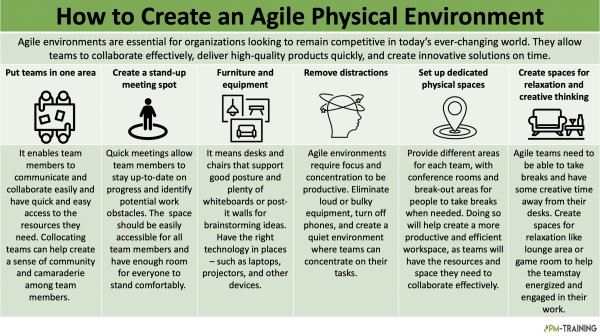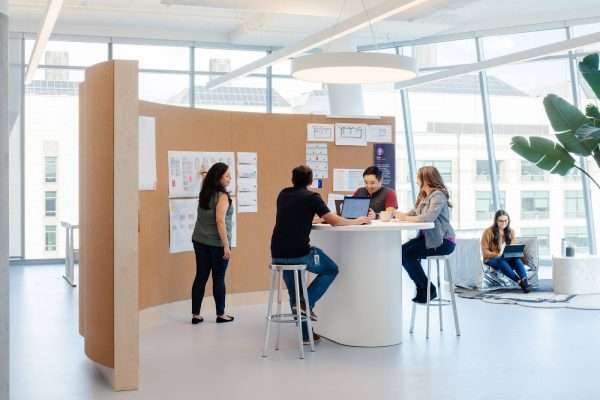Many organizations today that have adapted to the agile way of working understand the importance of creating agile environments in the workplace. Aside from agile project management methodology, the agile framework can further be supported by creating spaces that make agile even more practiced in the workspace.
So how can you create an agile environment? Read on to learn more.
In general, an agile environment is one that is geared towards responding quickly and efficiently to change. This can be contrasted with a non-agile environment, which is more focused on stability and predictability.
There are a number of characteristics that tend to be associated with an agile environment.
For instance, it is often said that agile environments are “iterative” and “incremental.” This means that they are constantly evolving, as opposed to being static. Agile environments are also typically very collaborative, with a strong emphasis on communication and teamwork.
In addition, they are often highly adaptable, and able to rapidly respond to new challenges or opportunities.
Lastly, the environment tends to be very results-oriented and focused on delivering value to the customer or user. All of these characteristics combine to create an environment that is ideally suited for rapidly changing conditions.

Characteristics of an Agile Environment
Several characteristics are common to agile environments. Firstly, agile environments are typically highly collaborative, with teams working closely together to achieve common goals.
Secondly, agile environments tend to be very flexible, allowing teams to adapt to changing circumstances rapidly. Next, agile environments often focus on continuous improvement, with teams constantly striving to optimize their processes and outcomes.
Finally, agile environments are usually open to high iterations, meaning that team members frequently revise and improve their work. Ultimately, these characteristics create an environment where teams can quickly and efficiently deliver high-quality products and services.

How to Create an Agile Physical Environment
There are many ways to create an agile physical environment. The most important thing is to create a space conducive to collaboration and communication. It means creating an open layout with plenty of natural light and comfortable seating. It also means ensuring adequate meeting rooms and break-out areas for team members to use as needed. Here are a few tips to make that physical environment work for you
Put teams in one area
Teams must be collocated in one area to create an effective and efficient agile environment.
While there are some potential downsides to collocating teams, such as increased noise levels and distractions, the benefits far outweigh the drawbacks. It enables team members to communicate and collaborate easily and have quick and easy access to the resources they need.
Additionally, collocating teams can help create a sense of community and camaraderie among team members.
Create a stand-up meeting spot
The stand-up meeting is a crucial component of the Agile project management methodology. These quick meetings allow team members to stay up-to-date on progress and identify potential work obstacles.
To facilitate these regular stand-up meetings, creating a dedicated space where they can take place is essential. This space should be easily accessible for all team members and have enough room for everyone to stand comfortably.
Additionally, the area should be free from distractions so that team members can focus on the task. By creating a dedicated stand-up meeting spot, teams can stay on track and ensure that their work remains agile.
Furniture and equipment
Agile workspaces require comfortable furniture that is conducive to collaboration. It means desks and chairs that support good posture and plenty of whiteboards or post-it walls for brainstorming ideas. Having the right technology in places – such as laptops, projectors, and other devices – is vital to Agile success.
Remove distractions
Agile environments require focus and concentration to be productive, so removing anything that could potentially distract the team is important. It may mean eliminating loud or bulky equipment, turning off phones, and creating a quiet environment where teams can concentrate on their tasks.
Set up dedicated physical spaces for the teams
It means providing different areas for each team, with conference rooms and break-out areas for people to take breaks when needed. Doing so will help create a more productive and efficient workspace, as teams will have the resources and space they need to collaborate effectively. Additionally, ensuring the area is designed to promote creativity and innovation is vital.
For example, consider using open layouts and natural light. By creating a dedicated space for teams to work, you can create an environment conducive to agile working.
Create spaces for relaxation and creative thinking
Agile teams need to be able to take breaks and have some creative time away from their desks. Creating spaces for relaxation, such as a lounge area or game room, can help Agile teams stay energized and engaged in their work.
By following these Agile environment examples, businesses can create an optimal workspace that will help them implement Agile methodologies and reap the benefits they bring.
Agile environments are essential for organizations looking to remain competitive in today’s ever-changing world. They allow teams to collaborate effectively, deliver high-quality products quickly, and create innovative solutions on time. With the right Agile environment in place, businesses can unlock new levels of productivity and success.
Example of Agile Environments in the Workplace
There are many ways to foster the agile way of working in the workplace. Here are a few key examples of physical setups that help with the process.
Communal tables
Communal tables are a popular Agile environment example for spaces where teams can brainstorm and collaborate. By replacing traditional cubicles with tables accommodating multiple people, Agile organizations can foster collaboration and communication between team members.
Project rooms
Agile teams may require dedicated space to focus on specific projects. Project rooms provide a space for teams to discuss and plan tasks while having the privacy they need to concentrate.
Flexible seating
Agile organizations understand the importance of flexibility and comfort in their work environments, so agile offices often feature flexible seating options that allow employees to pick their workspace. It can include standing desks, comfortable couches, or bean bags – anything that encourages creativity and collaboration among team members.
By embracing Agile environment examples, organizations can create an open and collaborative work environment conducive to Agile success. Agile methodologies are proven processes for delivering high-quality products quickly.
Examples of Companies with Agile Environments
One of the most successful Agile-based companies is Google. The tech giant has adopted Agile methodologies across its entire organization to develop products and services more quickly than ever before. This Agile environment is evidenced in Google’s office design, which features open workspaces that encourage employee collaboration and communication.

Another example of Agile success comes from Dropbox, a cloud computing service provider that has leveraged Agile practices to become one of the leading providers in its field. Dropbox has created an Agile environment by providing employees with flexible seating options, open workspaces, and project rooms for brainstorming ideas.
Agile environments are key to helping organizations remain competitive in today’s rapidly changing marketplaces. Agile environments can be found at leading companies such as Amazon, Microsoft, and Apple. By embracing Agile principles, these companies have been able to streamline their processes and develop innovative products quickly.
Agile Environment in Software Engineering
In a rapidly changing world, it’s more important than ever for businesses to adapt quickly to new challenges. That’s why an Agile environment is so important in software engineering.
In an Agile environment, engineers work together to break down a project into smaller tasks that can be completed quickly and easily. It makes it possible for the team to make changes on the fly as new information arises, and it also helps to ensure that the final product is of high quality.
Agile environments are becoming increasingly popular in today’s business world, and for a good reason. They provide a flexible and adaptable way to get work done and help ensure that projects are completed on time and on budget. An Agile environment is a way to go if you’re looking for a software engineering team to help you stay ahead of the curve.

Creating an Agile environment is essential in any fast-paced and collaborative workplace. Agile environments also allow teams to adjust to changing requirements or customer demands quickly and easily.
Agile environments are great for keeping teams on track and helping deliver high-quality software quickly and efficiently. Such spaces should include comfortable furniture, adequate meeting rooms, and break-out areas for team members who need them, plus all the necessary technology for the Agile way.
By creating an agile physical environment that encourages collaboration, communication, and quick decision-making, teams can better utilize Agile Methodology for maximum efficiency with their projects.
